Previous issues
- Page Path
- HOME > Browse Articles > Previous issues
- [Korean]
- Effect of Post Heat Treatment on the Microstructure and Mechanical Properties of BCuP-5 Filler Metal Coating Layers Fabricated by High Velocity Oxygen Fuel Thermal Spray Process on Ag Substrate
- So-Yeon Park, Seong-June Youn, Jae-Sung Park, Kee-Ahn Lee
- J Powder Mater. 2022;29(4):283-290. Published online August 1, 2022
- DOI: https://doi.org/10.4150/KPMI.2022.29.4.283
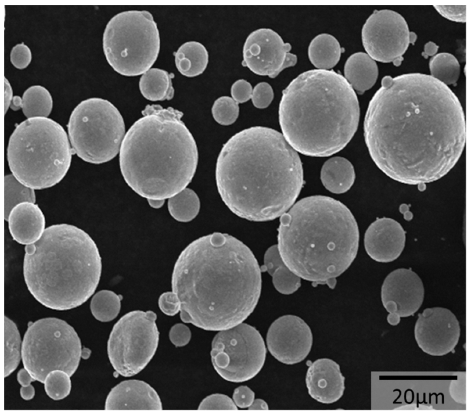
- 1,009 View
- 2 Download
- 1 Citations
-
 Abstract
Abstract
 PDF
PDF A Cu-15Ag-5P filler metal (BCuP-5) is fabricated on a Ag substrate using a high-velocity oxygen fuel (HVOF) thermal spray process, followed by post-heat treatment (300°C for 1 h and 400°C for 1 h) of the HVOF coating layers to control its microstructure and mechanical properties. Additionally, the microstructure and mechanical properties are evaluated according to the post-heat treatment conditions. The porosity of the heat-treated coating layers are significantly reduced to less than half those of the as-sprayed coating layer, and the pore shape changes to a spherical shape. The constituent phases of the coating layers are Cu, Ag, and Cu-Ag-Cu3P eutectic, which is identical to the initial powder feedstock. A more uniform microstructure is obtained as the heat-treatment temperature increases. The hardness of the coating layer is 154.6 Hv (as-sprayed), 161.2 Hv (300°C for 1 h), and 167.0 Hv (400°C for 1 h), which increases with increasing heat-treatment temperature, and is 2.35 times higher than that of the conventional cast alloy. As a result of the pull-out test, loss or separation of the coating layer rarely occurs in the heat-treated coating layer.
-
Citations
Citations to this article as recorded by- Evaluation and Prediction of Mechanical Properties According to Welding Methods of Ni 825/A516-70N Clad Plates
Cheolhong Hwang, Jeongseok Oh, Jini Park, Myungwoo Joe, Sunhwan Kim, Kyunghoon Yoo, Sungwoong Kim, Youngjoo Kim, Sangyeob Lee, Joonsik Park
Korean Journal of Metals and Materials.2024; 62(11): 844. CrossRef
- Evaluation and Prediction of Mechanical Properties According to Welding Methods of Ni 825/A516-70N Clad Plates
- [Korean]
- Effect of Polymeric Binders on Green body Properties of WC-Co Cemented Carbides
- Young-Soo Lim, Sun-Yong Ahn, Jae-Suk Lim, Yeong-Kyeun Paek, Tai-Joo Chung
- J Powder Mater. 2022;29(4):291-296. Published online August 1, 2022
- DOI: https://doi.org/10.4150/KPMI.2022.29.4.291
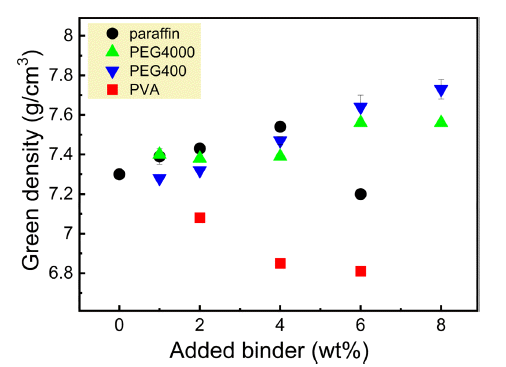
- 394 View
- 3 Download
-
 Abstract
Abstract
 PDF
PDF The green body of WC-Co cemented carbides containing polymeric binders such as paraffin, polyethylene glycol (PEG), and polyvinyl acetate (PVA) are prepared. The green density of the WC-Co cemented carbides increases with the addition of binders, with the exception of PVA, which is known to be a polar polymeric substance. The green strength of the WC-Co cemented carbides improves with the addition of paraffin and a mixture of PEG400 and PEG4000. In contrast, the green strength of the WC-Co does not increase when PEG400 and PEG4000 is added individually. The compressive strength of the green body increases to 14 MPa, and the machinability of the green body improves when more than 4–6 wt% paraffin and a mixture of PEG400 and PEG4000 is used. Simultaneously, the sintered density of WC-Co is as high as 99% relative density, similar to a low binder addition of 1–2 wt%.
- [Korean]
- Comparison Study of Compact Titanium Oxide (c-TiO2) Powder Electron Transport Layer Fabrication for Carbon Electrode-based Perovskite Solar Cells
- Chae Young Woo, Hyung Woo Lee
- J Powder Mater. 2022;29(4):297-302. Published online August 1, 2022
- DOI: https://doi.org/10.4150/KPMI.2022.29.4.297
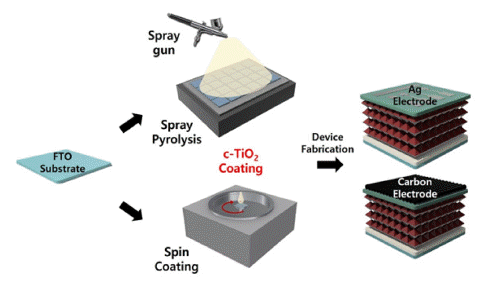
- 728 View
- 7 Download
-
 Abstract
Abstract
 PDF
PDF This study compares the characteristics of a compact TiO2 (c-TiO2) powdery film, which is used as the electron transport layer (ETL) of perovskite solar cells, based on the manufacturing method. Additionally, its efficiency is measured by applying it to a carbon electrode solar cell. Spin-coating and spray methods are compared, and spraybased c-TiO2 exhibits superior optical properties. Furthermore, surface analysis by scanning electron microscopy (SEM) and atomic force microscopy (AFM) exhibits the excellent surface properties of spray-based TiO2. The photoelectric conversion efficiency (PCE) is 14.31% when applied to planar perovskite solar cells based on metal electrodes. Finally, carbon nanotube (CNT) film electrode-based solar cells exhibits a 76% PCE compared with that of metal electrodebased solar cells, providing the possibility of commercialization.
- [Korean]
- Analysis of Anisotropic Plasticity of Additively Manufactured Structure using Modified Return Mapping Method
- Seung-Yong Yang, Doo-Han Jin, Jeoung-Han Kim
- J Powder Mater. 2022;29(4):303-308. Published online August 1, 2022
- DOI: https://doi.org/10.4150/KPMI.2022.29.4.303
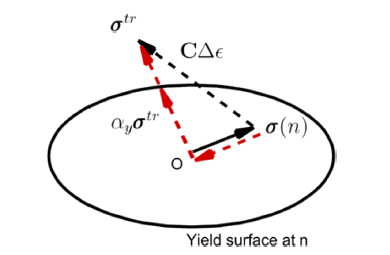
- 689 View
- 2 Download
-
 Abstract
Abstract
 PDF
PDF The plastic deformation behavior of additively manufactured anisotropic structures are analyzed using the finite element method (FEM). Hill’s quadratic anisotropic yield function is used, and a modified return-mapping method based on dual potential is presented. The plane stress biaxial loading condition is considered to investigate the number of iterations required for the convergence of the Newton-Raphson method during plastic deformation analysis. In this study, incompressible plastic deformation is considered, and the associated flow rule is assumed. The modified returnmapping method is implemented using the ABAQUS UMAT subroutine and effective in reducing the number of iterations in the Newton-Raphson method. The anisotropic tensile behavior is computed using the 3-dimensional FEM for two tensile specimens manufactured along orthogonal additive directions.
- [Korean]
- Evaluation of Microstructures and Mechanical Properties in Functionally Graded Materials (STS 316L and Low Alloy Steel) Produced by DED Processes
- G. Shin, W. Choo, J. H. Yoon, S. Y. Yang, J. H. Kim
- J Powder Mater. 2022;29(4):309-313. Published online August 1, 2022
- DOI: https://doi.org/10.4150/KPMI.2022.29.4.309
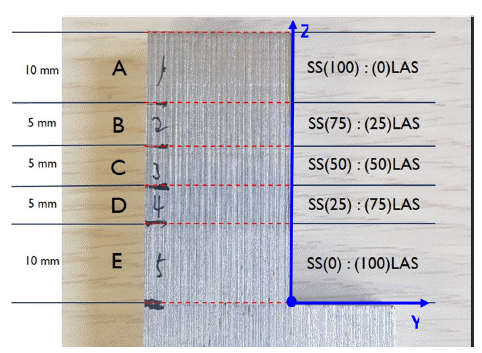
- 623 View
- 3 Download
-
 Abstract
Abstract
 PDF
PDF In this study, additive manufacturing of a functionally graded material (FGM) as an alternative to joining dissimilar metals is investigated using directed energy deposition (DED). FGM consists of five different layers, which are mixtures of austenitic stainless steel (type 316 L) and low-alloy steel (LAS, ferritic steel) at ratios of 100:0 (A layer), 75:25 (B layer), 50:50 (C layer), 25:75 (D layer), and 0:100 (E layer), respectively, in each deposition layer. The FGM samples are successfully fabricated without cracks or delamination using the DED method, and specimens are characterized using optical and scanning electron microscopy to monitor their microstructures. In layers C and D of the sample, the tensile strength is determined to be very high owing to the formation of ferrite and martensite structures. However, the elongation is high in layers A and B, which contain a large fraction of austenite.
- [Korean]
- Effect of Laser Beam Diameter on the Microstructure and Hardness of 17-4 PH Stainless Steel Additively Manufactured by Direct Energy Deposition
- Woo Hyeok Kim, UiJun Go, Jeoung Han Kim
- J Powder Mater. 2022;29(4):314-319. Published online August 1, 2022
- DOI: https://doi.org/10.4150/KPMI.2022.29.4.314
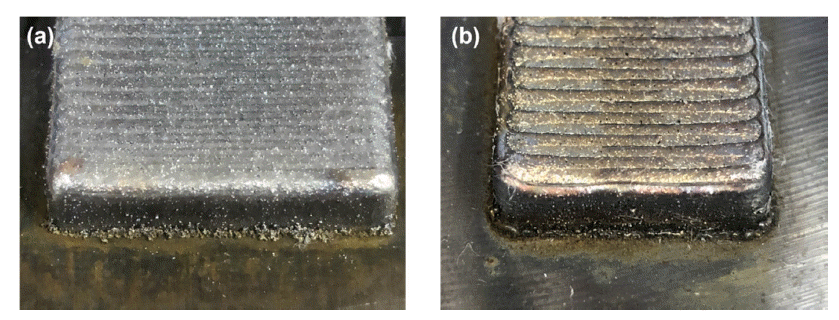
- 945 View
- 7 Download
- 3 Citations
-
 Abstract
Abstract
 PDF
PDF The effect of the laser beam diameter on the microstructure and hardness of 17-4 PH stainless steel manufactured via the directed energy deposition process is investigated. The pore size and area fraction are much lower using a laser beam diameter of 1.0 mm compared with those observed using a laser beam diameter of 1.8 mm. Additionally, using a relatively larger beam diameter results in pores in the form of incomplete melting. Martensite and retained austenite are observed under both conditions. A smaller width of the weld track and overlapping area are observed in the sample fabricated with a 1.0 mm beam diameter. This difference appears to be mainly caused by the energy density based on the variation in the beam diameter. The sample prepared with a beam diameter of 1.0 mm had a higher hardness near the substrate than that prepared with a 1.8 mm beam diameter, which may be influenced by the degree of melt mixing between the 17-4 PH metal powder and carbon steel substrate.
-
Citations
Citations to this article as recorded by- Mechanical response and microstructural evolution of a composite joint fabricated by green laser dissimilar welding of VCoNi medium entropy alloy and 17-4PH stainless steel
Hadiseh Esmaeilpoor, Mahdi Aghaahmadi, Hyun Jong Yoo, Chan Woong Park, Tae Jin Jang, Seok Su Sohn, Jeoung Han Kim
Journal of Materials Science & Technology.2025; 213: 223. CrossRef - Laser additive manufacturing of ceramic reinforced titanium matrix composites: A review of microstructure, properties, auxiliary processes, and simulations
Yuzhou Zeng, Jiandong Wang, Xuanrui Liu, Yu Xue, Lang Tang, Yunxiang Tong, Fengchun Jiang
Composites Part A: Applied Science and Manufacturing.2024; 177: 107941. CrossRef - Study on the Elemental Diffusion Distance of a Pure Nickel Layer Additively Manufactured on 316H Stainless Steel
UiJun Ko, Won Chan Lee, Gi Seung Shin, Ji-Hyun Yoon, Jeoung Han Kim
journal of Korean Powder Metallurgy Institute.2024; 31(3): 220. CrossRef
- Mechanical response and microstructural evolution of a composite joint fabricated by green laser dissimilar welding of VCoNi medium entropy alloy and 17-4PH stainless steel
- [Korean]
- Manufacturing of Fe-Mn-Al-C Based Low Mn Lightweight Steel Via Direct Energy Deposition
- Kwang Kyu Ko, Han Sol Son, Cha Hee Jung, Hyo Ju Bae, Eun Hye Park, Jung Gi Kim, Hyunjoo Choi, Jae Bok Seol
- J Powder Mater. 2022;29(4):320-324. Published online August 1, 2022
- DOI: https://doi.org/10.4150/KPMI.2022.29.4.320
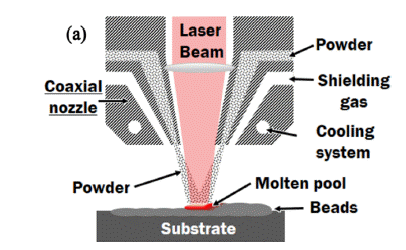
- 1,039 View
- 27 Download
-
 Abstract
Abstract
 PDF
PDF Lightweight steel is a crucial material that is being actively studied because of increased carbon emissions, tightening regulations regarding fuel efficiency, and the emergence of UAM, all of which have been recently labeled as global issues. Hence, new strategies concerning the thickness and size reduction of steel are required. In this study, we manufacture lightweight steel of the Fe-Mn-Al-C system, which has been recently studied using the DED process. By using 2.8 wt.% low-Mn lightweight steel, we attempt to solve the challenge of joining steel parts with a large amount of Mn. Among the various process variables, the laser scan power is set at 600 and 800W, and the laser scan speed is fixed at 16.67 mm/s before the experiments. Several pores and cracks are observed under both conditions, and negligibly small pores of approximately 0.5 μm are observed.
- [Korean]
- Effect of Iron Content on Microstructure and Mechanical Properties of Ti-Mo-Fe P/M Alloys
- HyoWoon Hwang, YongJae Lee, JiHwan Park, Dong-Geun Lee
- J Powder Mater. 2022;29(4):325-331. Published online August 1, 2022
- DOI: https://doi.org/10.4150/KPMI.2022.29.4.325
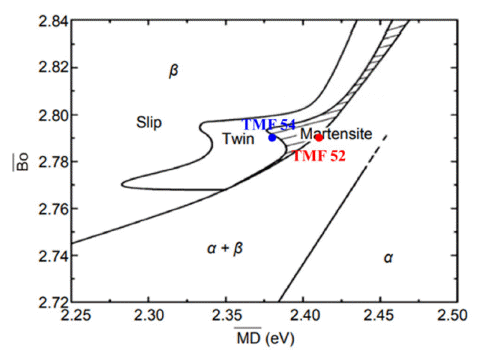
- 999 View
- 6 Download
- 2 Citations
-
 Abstract
Abstract
 PDF
PDF Beta-titanium alloys are used in many industries due to their increased elongation resulting from their BCC structure and low modulus of elasticity. However, there are many limitations to their use due to the high cost of betastabilizer elements. In this study, biocompatible Ti-Mo-Fe beta titanium alloys are designed by replacing costly betastabilizer elements (e.g., Nb, Zr, or Ta) with inexpensive Mo and Fe elements. Additionally, Ti-Mo-Fe alloys designed with different Fe contents are fabricated using powder metallurgy. Fe is a strong, biocompatible beta-stabilizer element and a low-cost alloying element. The mechanical properties of the Ti-Mo-Fe metastable beta titanium alloys are analyzed in relation to the microstructural changes. When the Fe content increases, the tensile strength and elongation decrease due to brittle fracture despite a decreasing pore fraction. It is confirmed that the hardness and tensile strength of Ti-5Mo-2Fe P/M improve to more than 360 Hv and 900 MPa, respectively.
-
Citations
Citations to this article as recorded by- Fabrication of Ti-Mo Core-shell Powder and Sintering Properties for Application as a Sputtering Target
Won Hee Lee, Chun Woong Park, Heeyeon Kim, Yuncheol Ha, Jongmin Byun, Young Do Kim
journal of Korean Powder Metallurgy Institute.2024; 31(1): 43. CrossRef - Effect of Strain Rate on Deformation Behaviors of Ti-12.1Mo -1Fe Metastable Beta Alloy
In Kyeong Jin, Dong-Geun Lee
Korean Journal of Metals and Materials.2023; 61(10): 741. CrossRef
- Fabrication of Ti-Mo Core-shell Powder and Sintering Properties for Application as a Sputtering Target
TOP
 KPMI
KPMI




 First
First Prev
Prev


